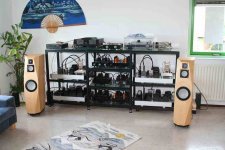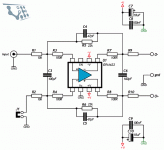ashok said:Hi Steve (Eddy),
Have you any idea where I can get those small laminations and the bobbin like the one in the picture you posted.
Thanks.
Ashok.
I don't know who exactly sources them for CineMag, but one source for laminations is Magnetic Metals and a source for bobbins is Cosmo Corporation.
Don't know what sort of minimums they may have.
se
The SSM2141 has 25k worth of build-out resistance. In 98% of real-world application, the unbalance in the source impedance will be pretty much swamped. Now, that won't be absolutely perfect, nor will it be true for that pesky 2% of cases, but that's why the massive 2 oz input transformer costs several multiples of the price of an SSM2141.
Steve_Eddy: " .. source imbalances due to the resistance tolerance of buildout resistors and even manufacturing tolerances of drawing the wire can result in source impedance imbalances sufficient to significantly degrate the CMRR of active balanced inputs. ... Some pro gear actually has trimmer resistors and capacitors on their outputs so that the source impedances can be precisely trimmed and be able to achieve something closer to the advertised CMRR. ..."
Sometimes there are ways around these input problems by "zeroing out" the input offsets ala something similsr to this method ... Refer to: http://tinaja.com/glib/muse116.pdf (pages 1 & 2) & http://focus.ti.com/docs/prod/folders/print/tlc4502.html ) Granted this may not an ideal solution, but it does take care of a world of sins at the input, balanced or unbalanced ...
... 'still got popcorn noise to deal with, however ...

Sometimes there are ways around these input problems by "zeroing out" the input offsets ala something similsr to this method ... Refer to: http://tinaja.com/glib/muse116.pdf (pages 1 & 2) & http://focus.ti.com/docs/prod/folders/print/tlc4502.html ) Granted this may not an ideal solution, but it does take care of a world of sins at the input, balanced or unbalanced ...
... 'still got popcorn noise to deal with, however ...

FastEddy said:So as not to confuse the issue(s) to much:
One amp's input transformer can be a pre-amp's output transformer ... same, same if the transformer were located on the amp, it might be called "input", located on the pre-amp it might be called "output".
Except that when building high quality transformers, input transformers and output transformers will be designed quite differently from one another and you wouldn't want to use an input transformer as an output transformer if you cared at all about performance.
There are some sizable output transformers on tube pre-amps that connect to the inputs of power amps ... I suppose one could say that these are the "input" matching transformers of the line amp, being used in the pre-amp to match the input of the balanced line(s) and the amp.
No, they're the output matching transformers of the line amp.
It used to be quite common to see tube pre-amps with heavy, good sized output transformers, sometimes as large as the speaker drive output transformers on the downstream line amps ...
That's because output transformers on tube preamps are typically used to load the plate and are gapped so they can handle the DC current flowing through their primaries. A gapped core means lower permeability which means more turns if you want to keep the primary inductance high, but more turns means higher resistance which can cause heating issues so larger wire is used to lower resistance which means you need a bigger core and so on.
If the output transformer doesn't have to handle any DC, it can be made much smaller and much lighter. The CineMag CMOQ-4 is only 1.45" wide, 1.2" tall, and 1" deep and weighs just 4 ounces.
Bigger impedence matching transformers = broader and better response curves, less succeptability to outside EMF interference, broader matching with a variety of snakes, etc ...
Just the opposite. Bigger is not always better. As the size of the transformer gets bigger, the parasitics also get bigger and you don't get the broader response curves, etc.
Just as an example, the CineMag CMOQ-4 I just mentioned is only 1.2dB down at 200kHz. Its big brother, the CMOQ-1, which is the same transformer but made on a much larger core, is down 3dB at 150kHz.
(I used to be licensed in three states to install this stuff = seen 'em, messed with 'em, installed 'em ...)
Pity you didn't learn anything about transformers along the way.
se
FastEddy said:Sometimes there are ways around these input problems by "zeroing out" the input offsets ala something similsr to this method ... Refer to: http://tinaja.com/glib/muse116.pdf (pages 1 & 2) & http://focus.ti.com/docs/prod/folders/print/tlc4502.html ) Granted this may not an ideal solution, but it does take care of a world of sins at the input, balanced or unbalanced ...
Input offset is not the same as source impedance imbalance. And given your demonstrated propensity to stick your fingers in your ears and shout "BLAH! BLAH! BLAH! I CAN'T HEAR YOU! BLAH! BLAH! BLAH!" I'm not even going to bother trying to explain it to you.
se
SY said:The SSM2141 has 25k worth of build-out resistance.
Huh?
Build out resistors are external resistors used in series with an opamp's output for load isolation. The resistors you seem to be speaking of here are the input resistors on the SSM2141.
In 98% of real-world application, the unbalance in the source impedance will be pretty much swamped.
Ya think? Here's what the SSM2141's datasheet has to say:
MAINTAINING COMMON-MODE REJECTION
In order to maintain the full common-mode rejection capability of the SSM2141, the source impedance must be carefully controlled. Slight imbalances of the source resistance will result in a degradation of DC CMR - even a 5 ohm imbalance will degrade CMR by 20dB. Also, the matching of the reactive source impedance must be matched in order to preserve the CMRR over frequency.
se
I see what you mean about the SSM2141 op-amp ( http://www.analog.com/UploadedFiles/Data_Sheets/SSM2141.pdf ) ... excellent slew rate / bandwidth ... " high level of noise immunity and optimum common-mode rejection" (unity gain) ... easy to impliment = simple 8-pin DIP X 2 for stereo. Page 6 of the PDF above has several reference circuits worthy of note ... inc. figure #5 (which suspiciously resembles the previous post/ image above with more modest gain).
Yes, it would make a very good, if not great balanced front end for an LM4502 amp.

Yes, it would make a very good, if not great balanced front end for an LM4502 amp.

BTW: Reinout responded by email to my Q&A about the weight of his I/O transformers.
" ... The first interstage is an EI75. 2 inch stack. Because of the high sensitive laminations (49% Permalloy) it is encased in a mumetal container and filled with resin. Weeght: only the bobin + laminatiosn easily 2 pounds. And encased.....way more. ..." (he sent construction & final assembly pictures as well = a very nice, well thought out setup.)

" ... The first interstage is an EI75. 2 inch stack. Because of the high sensitive laminations (49% Permalloy) it is encased in a mumetal container and filled with resin. Weeght: only the bobin + laminatiosn easily 2 pounds. And encased.....way more. ..." (he sent construction & final assembly pictures as well = a very nice, well thought out setup.)

Attachments
SY said:Sigh. I don't know why I'm saying this yet again, but... you're not talking about an input transformer. An interstage is a TOTALLY different animal.
He's hopeless, SY. Best to just forget about this thread.
se
SY said:Steve, I think you need to have a word with your brother Fast.
He ain't my brother. He's too heavy.
se
veteran: " ... to make balanced signal just use OPA1632 ... one of the best ..."
Sure looks like it. This would be a significant improvement over the balanced pre-amp input/output scenarios I have seen.
(My system scenario is basically a dual channel tube pre-amp with multiple balanced XLR connections driving a pure solid state power amp, hopefully using the LM4702 and Power MOSFETs to drive the speakers, optimizing weight considerations for use on the road. [I know of several music professionals who buy or lease new equipment in each of their big city engagements = it being too expensive to overnight ship all the extra gear from city to city, so they have to spend several hours, pre-show, to shake down, sound check and attempt to recreate their favorite pre-sets ...] ... tube pre-amps for that "mellow" sound, balanced interconnects for reliable, quality sound, weight being reduced where possible ... the solid state "voltage follower" amps being the weighty beasts, too heavy to ship week after week.)

Sure looks like it. This would be a significant improvement over the balanced pre-amp input/output scenarios I have seen.
(My system scenario is basically a dual channel tube pre-amp with multiple balanced XLR connections driving a pure solid state power amp, hopefully using the LM4702 and Power MOSFETs to drive the speakers, optimizing weight considerations for use on the road. [I know of several music professionals who buy or lease new equipment in each of their big city engagements = it being too expensive to overnight ship all the extra gear from city to city, so they have to spend several hours, pre-show, to shake down, sound check and attempt to recreate their favorite pre-sets ...] ... tube pre-amps for that "mellow" sound, balanced interconnects for reliable, quality sound, weight being reduced where possible ... the solid state "voltage follower" amps being the weighty beasts, too heavy to ship week after week.)

- Status
- This old topic is closed. If you want to reopen this topic, contact a moderator using the "Report Post" button.
- Home
- Amplifiers
- Chip Amps
- something with LM4702 and Power FET

